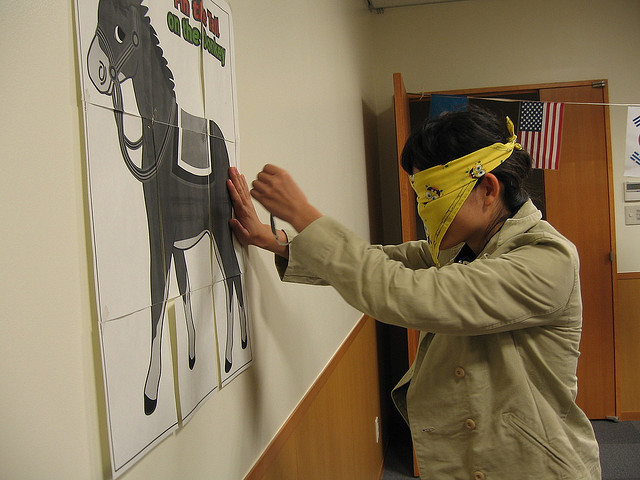Archive for the ‘The Future’ Category
Innovation’s Mantra – Sell New Products To New Customers
 There are three types of innovation: innovation that creates jobs, innovation that’s job neutral, and innovation that reduces jobs.
There are three types of innovation: innovation that creates jobs, innovation that’s job neutral, and innovation that reduces jobs.
Innovation that reduces jobs is by far the most common. This innovation improves the efficiency of things that already exist – the mantra: do the same, but with less. No increase in sales, just fewer people employed.
Innovation that’s job neutral is less common. This innovation improves what you sell today so the customer will buy the new one instead of the old one. It’s a trade – instead of buying the old one they buy the new one. No increase in sales, same number of people employed.
Innovation that creates jobs is uncommon. This innovation radically changes what you sell today and moves it from expensive and complicated to affordable and accessible. Sell more, employ more.
Clay Christensen calls it Disruptive Innovation; Vijay Govindarajan calls it Reverse Innovation; and I call it Less-With-Far-Less.
The idea is the product that is sold to a relatively small customer base (due to its cost) is transformed into something new with far broader applicability (due to its hyper-low cost). Clay says to “look down” to see the new technologies that do less but have a super low cost structure which reduces the barrier to entry. And because more people can afford it, more people buy it. And these aren’t the folks that buy your existing products. They’re new customers.
Vijay says growth over the next decades will come from the developing world who today cannot afford the developed world’s product. But, when the price comes down (down by a factor of 10 then down by a factor of 100), you sell many more. And these folks, too, are new customers.
I say the design and marketing communities must get over their unnatural fascination with “more” thinking. To sell to new customers the best strategy is increase the number of people who can afford your product. And the best way to do that is to radically reduce the cost signature at the expense of features and function. If you can give ground a bit on the thing that makes your product successful, there is huge opportunity to reduce cost – think 80% less cost and 20% less function. Again, you sell new product to new customers.
Here’s a thought experiment to help put you in the right mental context: Create a plan to form a new business unit that cannot sell to your existing customers, must sell a product that does less (20%) and costs far less (80%), and must sell it in the developing world. Now, create a list of small projects to test new technologies with radically lower cost structures, likely from other industries. The constraint on the projects – you must be able to squeeze them into your existing workload and get them done with your existing budget and people. It doesn’t matter how long the projects take, but the investment must be below the radar.
The funny thing is, if you actually run a couple small projects (or even just one) to identify those new technologies, for short money you’ve started your journey to selling new products to new customers.
Marketing’s Holy Grail – Emerging Customer Needs
 The Holy Grail of marketing is to identify emerging customer needs before anyone else and satisfy them to create new markets. It has been a long and fruitless slog as emerging needs have proven themselves elusive. And once candidates are identified, it’s a challenge to agree which are the game-changers and which are the ghosts. There are too many opinions and too few facts. But there’s treasure at the end of the rainbow and the quest continues.
The Holy Grail of marketing is to identify emerging customer needs before anyone else and satisfy them to create new markets. It has been a long and fruitless slog as emerging needs have proven themselves elusive. And once candidates are identified, it’s a challenge to agree which are the game-changers and which are the ghosts. There are too many opinions and too few facts. But there’s treasure at the end of the rainbow and the quest continues.
Emerging things are just coming to be, just starting, so they appy to just a small subset of customers; and emerging things are new and different, so they’re unfamiliar. Unfamiliar plus small same size equals elusive.
I don’t believe in emerging customer needs, I believe in emergent customer behavior.
Emergent behavior is based on actions taken (past tense) and is objectively verifiable. Yes or no, did the customer use the product in a new way? Yes or no, did the customer make the product do something it wasn’t supposed to? Did they use it in a new industry? Did they modify the product on their own? Did they combine it with something altogether unrelated? No argument.
When you ask a customer how to improve your product, their answers aren’t all that important to them. But when a customer takes initiative and action, when they do something new and different with your product, it’s important to them. And even when just a few rouge customers take similar action, it’s worth understanding why they did it – there’s a good chance there’s treasure at the end of that rainbow.
With traditional VOC methods, it has been cost prohibitive to visit enough customers to learn about a handful at the fringes doing the same crazy new thing with your product. Also, with traditional VOCs, these “outliers” are thrown out because they’re, well, they’re outliers. But emergent behavior comes from these very outliers. New information streams and new ways to visualize them are needed to meet these challenges.
For these new information streams, think VOC without the travel; VOC without leading the witness; VOC where the cost of capturing their stories is so low there are so many stories captured that it’s possible to collect a handful of outliers doing what could be the seed for the next new market.
To reduce the cost of acquisition, stories are entered using an app on a smart phone; to let emergent themes emerge, customers code their own stories with a common, non-biasing set of attributes; and to see patterns and outliers, the coded stories are displayed visually.
In the past, the mechanisms to collect and process these information streams did not exist. But they do now.
I hope you haven’t given up on the possibility of understanding what your customers will want in the near future, because it’s now possible.
I urge you to check out SenseMaker.
Do The Work No One Is Asking For
 We spend too much time on the mundane. Every day people come to work, turn on their PCs, and the mundane magically happens on its own accord. Email gets sent, phones get answered, mail gets delivered, and processes get followed. And after lunch, the hamster wheel spins back up and the mundane consumes the rest of our day. Yet there’s no need because that stuff runs on its own. It’s time to leave it alone and manage the mundane by exception. If there’s a hiccup, give it a drink of water, and otherwise leave it alone. It’s time to recognize the massive opportunity cost of the mundane – mundane comes at the expense of meaningful.
We spend too much time on the mundane. Every day people come to work, turn on their PCs, and the mundane magically happens on its own accord. Email gets sent, phones get answered, mail gets delivered, and processes get followed. And after lunch, the hamster wheel spins back up and the mundane consumes the rest of our day. Yet there’s no need because that stuff runs on its own. It’s time to leave it alone and manage the mundane by exception. If there’s a hiccup, give it a drink of water, and otherwise leave it alone. It’s time to recognize the massive opportunity cost of the mundane – mundane comes at the expense of meaningful.
But when the mundane withers and there’s finally time for meaningful, there’s another chasm to cross – no one asks for meaningful work. Because meaningful work makes a difference and making a difference threatens the legacy of success, no one asks you for it. Because it’s considered impossible, there’s no request to do it. And because it’s considered a strength of your business, no one suggests you dismantle it. Crazy, but it’s time to stop the mundane so you can start doing work no one is asking you to do.
But it’s not any old work no one is asking for, it’s a special flavor, a flavor that meets a tight set of criteria.
Don’t do it unless it will make a difference. But not any old difference, a difference of epic proportions. If you explain the concept to the customer and they want to buy ten, you’re on the right track. If after you show the prototype the customer won’t give it back to you with a wrestling match, that’s the right work. If you present the concept to the core business unit and they immediately try to scuttle it, you’re on to something.
Don’t do it unless it resonates with you, personally. As subject matter expert, it must make your hair stand on end. As the inventor who must swim against the tide of “you can’t do that”, it must fill your deep need to help others. As the pariah who threatens the success of the company, it must be more than an idea – it must be part of you.
Leaders – it’s time to ask your people to work on things that are meaningful to them. Give them four hours a week and ask for an informal fifteen minute presentation every other week. They’ll make extreme progress and amaze you. Magically, because they’ll be so charged up, there will be time for all the work. Morale will skyrocket, the best folks will ask to work on your team, and you’ll have working prototypes for all the things you should have asked for.
The Complexity Conundrum
 In school the problems you were given weren’t really problems at all. In school you opened the book to a specific page and there, right before you in paragraph form and numbered consecutively, was a neat row of “problems”. They were fully-defined, with known inputs, a formal equation that defined the system’s response, and one right answer. Nothing extra, nothing missing, nothing contradictory. Today’s problems are nothing like that.
In school the problems you were given weren’t really problems at all. In school you opened the book to a specific page and there, right before you in paragraph form and numbered consecutively, was a neat row of “problems”. They were fully-defined, with known inputs, a formal equation that defined the system’s response, and one right answer. Nothing extra, nothing missing, nothing contradictory. Today’s problems are nothing like that.
Today’s problems don’t have a closed form solution; today’s problems don’t have a right answer. Three important factors come into play: companies and their systems are complex; the work, at some level, is always new; and people are always part of the equation.
It’s not that companies have a lot of moving parts (that makes them complicated); it’s that the parts can respond differently in different situations, can change over time (learn), and the parts can interact and change each others’ response (that’s complex). When you’re doing work you did last time, there’s a pretty good chance the system will perform like it did last time. But it’s a different story when the inputs are different, when the work is new.
When the work is new, there’s no precedent. The inputs are new and the response is newer. Perturb the system in a new way and you’re not sure how it will respond. New interactions between preciously unreactive parts make for exciting times. The seemingly unconnected parts ping each other through the ether, stiffen or slacken, and do their thing in a whole new way. Repeatability is out the window, and causal predictability is out of the question. New inputs (new work) slathers on layers of unknownness that must be handled differently.
Now for the real complexity culprit – people. Companies are nothing more than people systems in the shape of a company. And the work, well, that’s done by people. And people are well known to be complex. In a bad mood, we respond one way; confident and secure we respond in another. And people have memory. If something bad happened last time, next time we respond differently. And interactions among people are super complex – group think, seniority, trust, and social media.
Our problems swim with us in a hierarchical sea of complexity. That’s just how it is. Keep that in mind next time you put together your Gantt chart and next time you’re asked to guarantee the outcome of an innovation project.
Complexity is real, and there are real ways to handle it. But that’s for another time. Until then, I suggest you bone up on Dave Snowden’s work. When it comes to complexity, he’s the real deal.
Image credit – miguelb.
The Illusion of Planning
Planning is important work, but it’s non-value added work. Short and sweet – planning is waste.
Lean has taught us waste should be reduced, and the best way to reduce waste from planning is to spend less time planning. (I feel silly writing that.) Lean has taught us to reduce batch size, and the best way to reduce massive batch size of the annual planning marathon is to break it into smaller sessions. (I feel silly writing that too.)
Unreasonable time constraints increase creativity. To create next year’s plan, allocate just one for the whole thing. (Use a countdown timer.) And, because batch size must be reduced, repeat the process monthly. Twelve hours of the most productive planning ever, and countless planning hours converted into value added work.
Defining the future state and closing the gap is not the way to go. The way to go is to define the current state (where you are today) and define how to move forward. Use these two simple rules to guide you:
- Do more of what worked.
- Do less of what didn’t.
Here’s an example process:
The constraint – no new hires. (It’s most likely the case, so start there.)
Make a list of all the projects you’re working on. Decide which to stop right now (the STOP projects) and which you’ll finish by the end of the month (the COMPLETED projects). The remaining projects are the CONTINUE projects, and, since they’re aptly named, you should continue them next month. Then, count the number of STOP and COMPLETED projects – that’s the number of START projects you can start next month.
If the sum of STOP and COMPLETED is zero, ask if you can hire anyone this month. If the answer is no, see you next month.
If the sum is one, figure out what worked well, figure out how to build on it, and define the START project. Resources for the START project should be the same as the STOP or COMPLETED project.
If the sum is two, repeat.
Now ask if you can hire anyone this month. If the answer is no, you’re done. If the answer is yes, define how many you can hire.
With your number in hand, and building on what worked well, figure out the right START project. Resources must be limited by the number of new hires, and the project can’t start until the new hire is hired. (I feel silly writing that, but it must be written.) Or, if a START project can’t be started, use the new resource to pile on to an important CONTINUE project.
You’re done for the month, so send your updated plan to your boss and get back to work.
Next month, repeat.
The process will evolve nicely since you’ll refine it twelve times per year.
Ultimately, planning comes down to using your judgment to choose the next project based on the resources you’re given. The annual planning process is truly that simple, it’s just doesn’t look that way because it’s spread over so many months. So, if the company tells its leaders how many resources they have, and trusts them to use good judgment, yearly planning can be accomplished in twelve hours per year (literally). And since the plan is updated monthly, there’s no opportunity for emergency re-planning, and it will always be in line with reality.
Less waste and improved quality – isn’t that what lean taught us?
How Things Really Happen
From the outside it’s unclear how things happen; but from the inside it’s clear as day. No, it’s not your bulletproof processes; it’s not your top down strategy; and it’s not your operating plans. It’s your people.
At some level everything happens like this:
An idea comes to you that makes little sense, so you drop it. But it comes again, and then again. It visits regularly over the months and each time reveals a bit of its true self. But still, it’s incomplete. So you walk around with it and it eats at you; like a parasite, it gets stronger at your expense. Then, it matures and grows its voice – and it talks to you. It talks all the time; it won’t let you sleep; it pollutes you; it gets in the way; it colors you; and finally you become the human embodiment of the idea.
And then it tips you. With one last push, it creates enough discomfort to roll over the fear of acknowledging its existence, and you set up the meeting.
You call the band and let them know it’s time again to tour. You’ve been through it before and you all know deal. You know your instruments and you know how to harmonize. You know what they can do (because they’ve done it before) and you trust them. You sing them the song of your idea and they listen. Then you ask them to improvise and sing it back, and you listen. The mutual listening moves the idea forward, and you agree to take a run at it.
You ask how it should go. The lead vocalist tells you how it should be sung; the lead guitar works out the fingering; the drummer beats out the rhythm; and the keyboardist grins and says this will be fun. You all know the sheet music and you head back to your silos to make it happen.
In record time, the work gets done and you get back together to review the results. As a group you decide if the track is good enough play in public. If it is, you set up the meeting with a broader audience to let them hear your new music. If it’s not, you head back to the recording studio to amplify what worked and dampen what didn’t. You keep re-recording until your symphony is ready for the critics.
Things happen because artists who want to make a difference band together and make a difference. With no complicated Gantt chart, no master plan, no request for approval, and no additional resources, they make beautiful music where there had been none. As if from thin air, they create something from nothing. But it’s not from thin air; it’s from passion, dedication, trust, and mutual respect.
The business books over-complicate it. Things happen because people make them happen – it’s that simple.
Can It Grow?
 If you’re working in a company you like, and you want it to be around in the future, you want to know if it will grow. If you’re looking to move to a new company, you want to know if it has legs – you want to know if it will grow. If you own stock, you want to know if the company will grow, and it’s the same if you want to buy stock. And it’s certainly the case if you want to buy the whole company – if it can grow, it’s worth more.
If you’re working in a company you like, and you want it to be around in the future, you want to know if it will grow. If you’re looking to move to a new company, you want to know if it has legs – you want to know if it will grow. If you own stock, you want to know if the company will grow, and it’s the same if you want to buy stock. And it’s certainly the case if you want to buy the whole company – if it can grow, it’s worth more.
To grow, a company has to differentiate itself from its competitors. In the past, continuous improvement (CI) was a differentiator, but today CI is the minimum expectation, the cost of doing business. The differentiator for growth is discontinuous improvement (DI).
With DI, there’s an unhealthy fascination with idea generation. While idea generation is important, companies aren’t short on ideas, they’re short on execution. But the one DI differentiator is the flavor of the ideas. To do DI a company needs ideas that are radically different than the ones they’re selling now. If the ideas are slightly twisted variants of today’s products and business models, that’s a sure sign continuous improvement has infiltrated and polluted the growth engine. The gears of the DI engine are gummed up and there’s no way the company can sustain growth. For objective evidence the company has the chops to generate the right ideas, look for a process that forces their thinking from the familiar, something like Jeffrey Baumgartner’s Anticonventional Thinking (ACT).
For DI-driven growth, the ability to execute is most important. With execution, the first differentiator is how the company investigates radically new ideas. There are three differentiators – a focus on speed, a “market first” approach, and the use of minimum viable tests (MVTs). With new ideas, it’s all about how fast you can learn, so speed should come through loud and clear. Without a market, the best idea is worthless, so look for “market first” thinking. Idea evaluation starts with a hypothesis that a specific market exists (the market is clearly defined in the hypothesis) which is evaluated with a minimum viable test (MVT) to prove or disprove the market’s existence. MVTs should error on the side of speed – small, localized testing. The more familiar minimum viable product (MVP) is often an important part of the market evaluation work. It’s all about learning about the market as fast as possible.
Now, with a validated market, the differentiator is how fast company can rally around the radically new idea and start the technology and product work. The companies that can’t execute slot the new project at the end of their queue and get to it when they get to it. The ones that can execute stop an existing (lower value) project and start the new project yesterday. This stop-to-start behavior is a huge differentiator.
The company’s that can’t execute take a ready-fire-aim approach – they just start. The companies that differentiate themselves use systems thinking to identify gaps in resources and capabilities and close them. They do the tough work of prioritizing one project over another and fully staff the important ones at the expense of the lesser projects. Rather than starting three projects and finishing none, the companies that know how to do DI start one, finish one, and repeat. They know with DI, there’s no partial credit for a project that’s half done.
All companies have growth plans, and at the highest level they all hang together, but some growth plans are better than others. To judge the goodness of the growth plan takes a deeper look, a look into the work itself. And once you know about the work, the real differentiator is whether the company has the chops to execute it.
Image credit – John Leach.
An Injection Of Absurdity
Things are cyclic, but there seems to be no end to the crusade of continuous improvement. (Does anyone remember how the Crusades turned out?) If only to take the edge off, there needs to be an injection of absurdity.
There’s no pressure with absurdity – no one expects an absurd idea to work. If you ask for an innovative idea, you’ll likely get no response because there’s pressure from the expectation the innovative idea must be successful. And if you do get a response, you’ll likely get served a plain burrito of incremental improvement garnished with sour cream and guacamole to trick your eye and doused in hot sauce to trick your palate. If you ask for an absurd idea, you get laughter and something you’ve never heard before.
When drowning in the sea of standard work, it takes powerful mojo to save your soul. And the absurdity jetpack is the only thing I know with enough go to launch yourself to the uncharted oasis of new thinking. Immense force is needed because continuous improvement has serious mass – black hole mass. Like with light, a new idea gets pulled over the event horizon into the darkness of incremental thinking. But absurdity doesn’t care. It’s so far from the center lean’s pull is no match.
But to understand absurdity’s superpower is to understand what makes things absurd. Things are declared absurd when they cut against the grain of our success. It’s too scary to look into the bright sun of our experiences, so instead of questioning their validity and applicability, the idea is deemed absurd. But what if the rules have changed and the fundamentals of last year’s success no longer apply? What if the absurd idea actually fits with the new normal? In a strange Copernican switch, holding onto to what worked becomes absurd.
Absurd ideas sometimes don’t pan out. But sometimes they do. When someone laughs at your idea, take note – you may be on to something. Consider the laughter an artifact of misunderstanding, and consider the misunderstanding a leading indicator of the opportunity to reset customer expectations. And if someone calls your idea absurd, give them a big hug of thanks, and get busy figuring out how to build a new business around it.
Retreating From Activity To Progress
 Every day is a meeting-to-meeting sprint with no time for some of the favorite fundamentals like the bathroom and food. Though crazy, it’s the norm and no longer considered crazy. But it is crazy. When you’re too busy to answer emails that’s one thing, but when you’re too busy to realize answering email isn’t progress, that’s a problem.
Every day is a meeting-to-meeting sprint with no time for some of the favorite fundamentals like the bathroom and food. Though crazy, it’s the norm and no longer considered crazy. But it is crazy. When you’re too busy to answer emails that’s one thing, but when you’re too busy to realize answering email isn’t progress, that’s a problem.
Our in-boxes are full; our plates are full; our calendars are full. But our souls are empty.
You’re clear on what must get done over the next 48 hours, but the pace is too fast to know why the work is important in the first place. (One of the fastest way to complete a task is to deem it unimportant and don’t do it – all of the done with none of the work.) But it’s worse. It’s too fast to do the work no one is asking you to do, and it’s too fast to do the work you were born to do.
We have confused activity with progress; and with all the activity, we’ve forgotten what it feels like to think. We need a retreat.
The perfect retreat eliminates distractions and gives people time to think. After a nice Sunday flight into Boston, it’s a calm two hour coach ride to rural New Hampshire. (Done right, a coach is soothing.) After pickup it’s a fifteen minute drive to a remote trail head. With a pack on your back, it’s a five minute walk to a big, remote cabin. No cell service, no power, no interruptions.
As you enter the cabin, you unload all your electronics into bin (Yes, your smart phone goes in the bin.) which is locked away for the remainder of the retreat. You race to get the best bunk, drop your gear, and share a meal with your fellow over achievers. (Y es, the non-disclosures are signed so you can actually talk to each other.)
The first day is all about recognizing the discomfort that comes with no distractions and your natural tendency to create distraction to sooth your discomfort. The objective is to help you remember what if feels like to have more than 30 seconds of uninterrupted time. Then, once you remember, it’s time to actually think.
There are no video conferencing capabilities (or electricity) in the cabin, so all work is done the old-fashioned way – face-to-face. The objective is to help you remember the depth, complexity, and meaning that come when working with actual faces. Yes, there’s good facilitated discussion, but the topics aren’t as important as remembering how to share and trust.
There is ritualistic work of cooking, cleaning, splitting the wood, and stoking the fire. The objective is to remember what it feels like to connect the mind to the body and to connect with others. And, there’s a group hike every day to remember what it feels like to be grounded in the natural world. (Sometimes we forget the business world is actually part of the natural world.)
After the rituals and hikes have done their magic, the right discussions start to emerge, and deep contemplation dances with deep conversation. Though there’s a formal agenda, no matter. With the group’s awaking, the right agenda emerges.
At the end of the retreat, there’s immense sadness. This is a sign of importance and deep learning. And after the hugs and tears, there’s a spontaneous commitment to do it next year. With eyes dried, it’s off the bus station and then to the airport.
You don’t have to wait for the perfect retreat to start your journey. Start your practice by carving out an hour a day and set a recurring meeting with yourself and turn off your email. And start by asking yourself why. Those two tricks will set you on your way.
And if you’re interested in a real retreat, let me know.
The Importance Of Knowing Why You’re In The Boat
Whether at work or home, there are highs and lows. And you’re not getting special treatment, that’s how it is for everyone. And it’s a powerful fundamental, so don’t try to control it, ride it.
When the sailing is smooth, at some point it won’t be – the winds change, that’s what they do. And when you’re suddenly buffeted from a new direction, you take action. But what action? More sail or less? Port or starboard? Heave the anchor or abandon ship? It depends.
Your actions depend on your why. Regardless of wind or tide, your why points where it points and guides your actions. Much like magnetic north doesn’t move if you spin your compass, your long term why knows where it points. If the storm on the horizon is dead ahead, you go around it. But it’s a balance – deviate to skirt the storm, but do it with your long term destination in mind. If you know your long term why, the best course heading is clear.
Often you set sail without realizing you don’t have your why battened down and stowed. When you sail where you sailed last time, you know the landmarks and use them to navigate. You can unknowingly leave your why at the pier and still get to your destination. But when you’re blown out to sea and can no longer see the landmarks, your moral compass, your long term why, is the only way to tack and jibe toward your destination.
Before you set sail, it’s best to know why you’re in the boat.
A Singular Pillar of Productivity
 Productivity generates profit. No argument. But it has two sides – it can be achieved through maximization by increasing output with constant resources (machines and people) or through minimization with constant output and decreasing machines and people. And the main pillars of both flavors are data, tools, and process.
Productivity generates profit. No argument. But it has two sides – it can be achieved through maximization by increasing output with constant resources (machines and people) or through minimization with constant output and decreasing machines and people. And the main pillars of both flavors are data, tools, and process.
Data is used to understand how things are going so they can be made more productive. Process output is measured, yields are measured, and process control charts are hung on the wall like priceless art. Output goes up and costs go down. And the two buckets of cost – people and machines – are poured out the door. But data on its own doesn’t know how to improve anything. The real heroes are the people that look at the data and use good judgment to make good decisions.
You can pull the people out of the process to reduce costs, but you can’t pull the judgment out productivity improvement work. And here’s the difference – processes are made transactional and repetitive so people can be removed, and because judgment can’t be made into a transactional process, people are needed to do productivity improvement work. People and their behavior – judgment – are the keys.
Tools are productivity’s golden children. Better tools speed up the work so more can get done. In the upswing, output increases to get more work done; in the downturn, people leave to reduce cost. Tools can increase the quality (maximize) or reduce the caliber of the people needed to do the work (minimize). But the tools aren’t the panacea, the real panacea are the people that run them.
Any analytical tool worth its salt requires judgment by the person that runs it. And here’s where manufacturing’s productivity-through-process analogy is pushed where it doesn’t belong. Companies break down the process to run the tools into 6000 to 7000 simple steps, stuff them into a 500 page color-coded binder, provide a week of training and declare standard work has saved the day because, now that the process has been simplified and standardized, everyone can run the tool at 100% efficiency. But the tool isn’t the important part, neither is the process of using it. The important part is the judgment of the people running it.
Productivity of tools is not measured in the number of design cycles per person or the number of test cases run per day. This manufacturing thinking must be banished to its home country – the production floor. The productivity of analytical tools is defined by the goodness of the output when the time runs out. And at the end of the day, measuring the level of goodness also requires judgment – judgment by the experts and super users. With tools, it’s all about judgment and the people exercising it.
And now process. When the process is made repetitive, repeatable, and transactional, it brings productivity. This is especially true when the process lets itself to being made repetitive, repeatable, and transactional. Here’s a good one – step 1, step 2, step 3, repeat for 8 hours. Dial it in and watch the productivity jump. But when it’s never been done before, people’s judgment governs productivity; and when the process has no right answer, the experts call the ball. When processes are complex, undefined, or the first of their kind, productivity and judgment are joined at the hip.
Processes, on their own, don’t rain productivity from the sky; the real rainmakers are the people that run them.
Today’s battle for productivity is overwhelmingly waged in the trenches of minimization, eliminating judgment skirmish by skirmish. And productivity’s “more-with-less” equation has been toppled too far toward “less”, minimizing judgment one process at a time.
Really, there’s only one pillar of productivity, and that’s people. As everyone else looks to eliminate judgment at every turn, what would your business look like if you went the other way? What if you focused on work that demanded more judgment? I’m not sure what it would look like, other than you’d have little competition.




 Mike Shipulski
Mike Shipulski